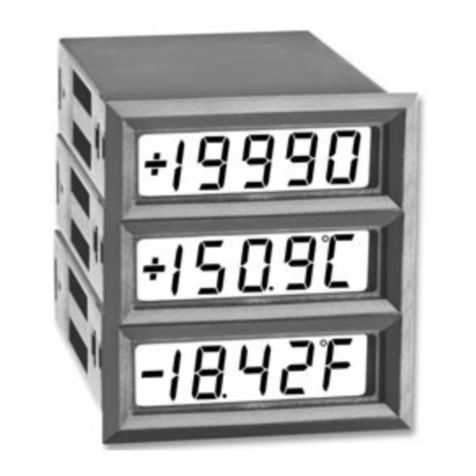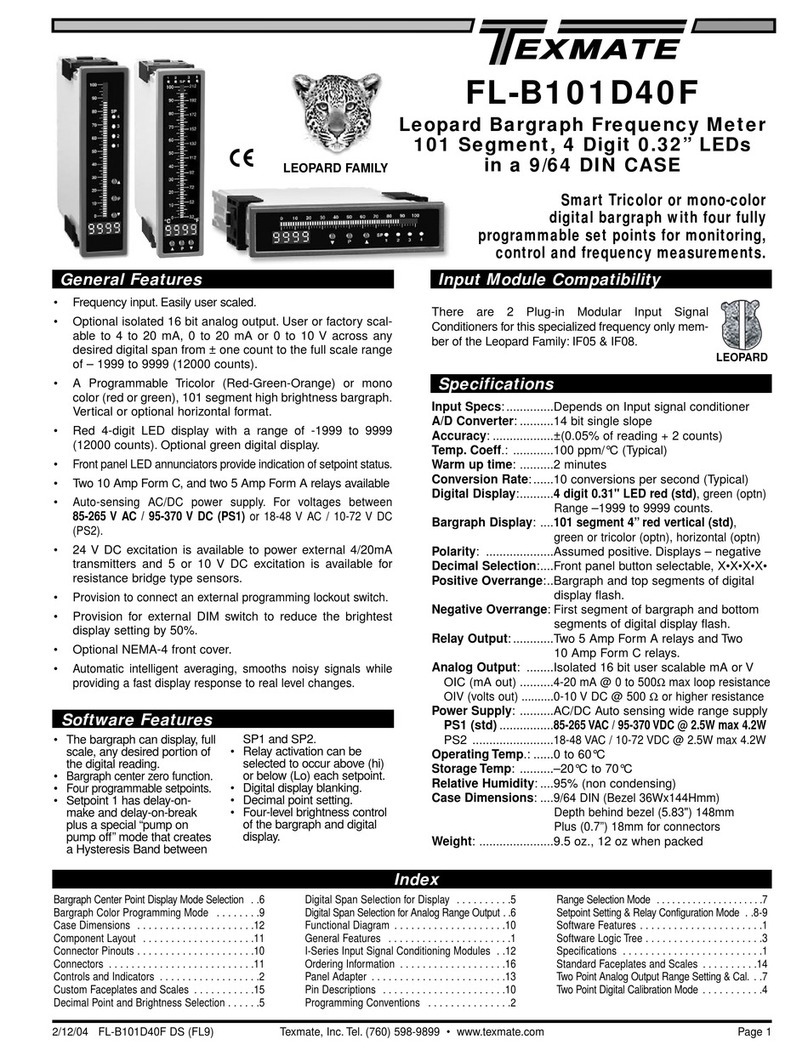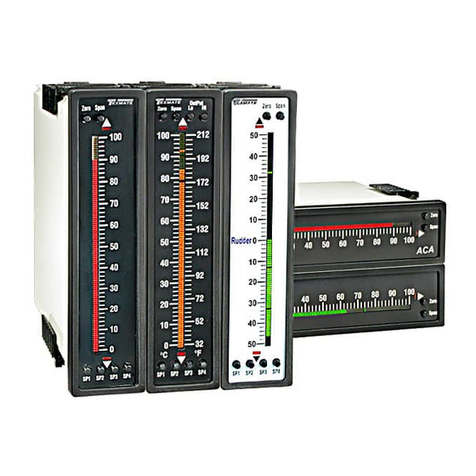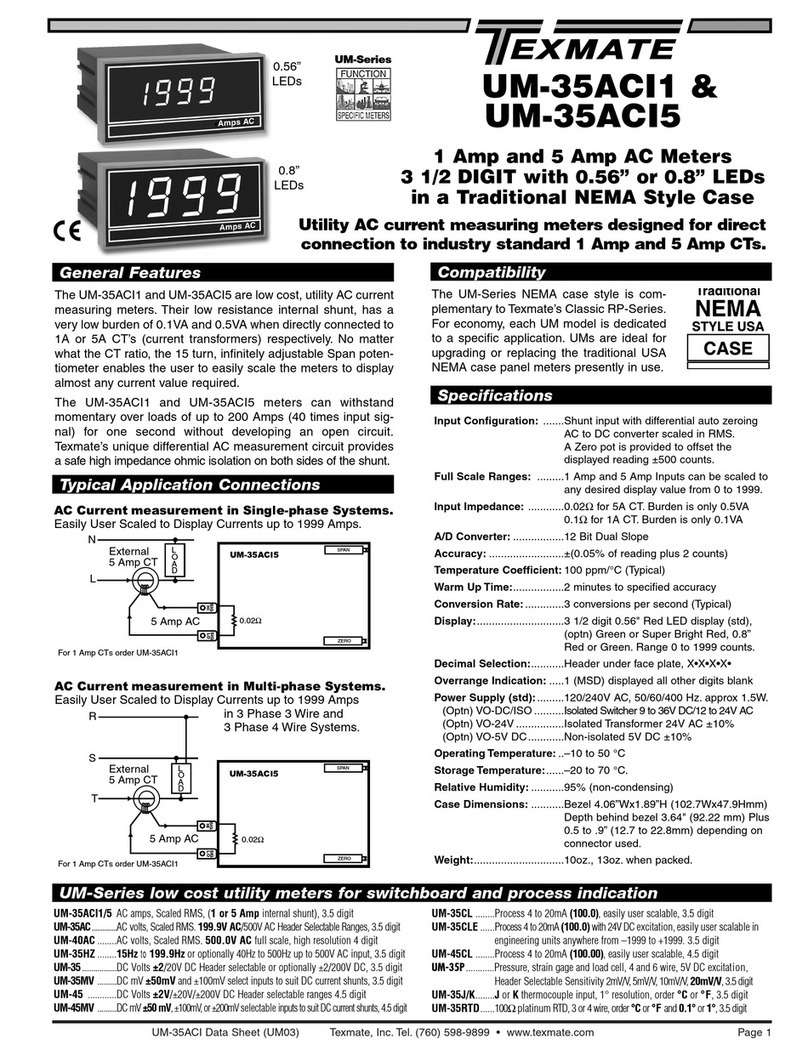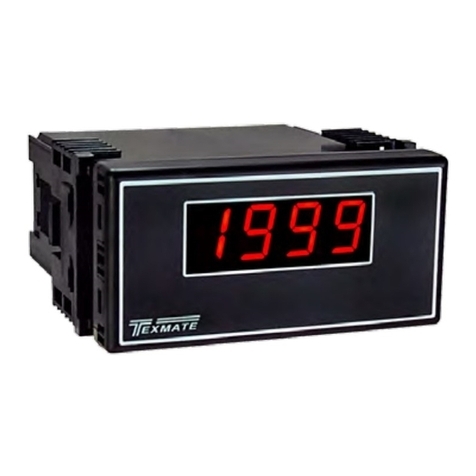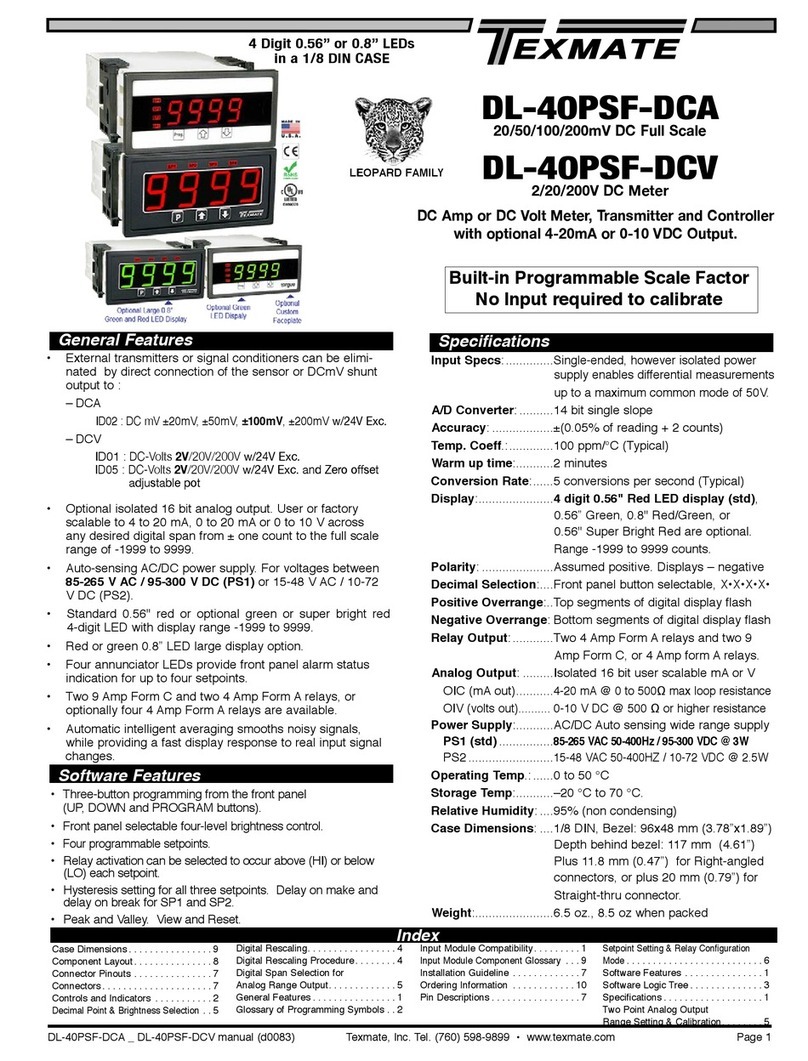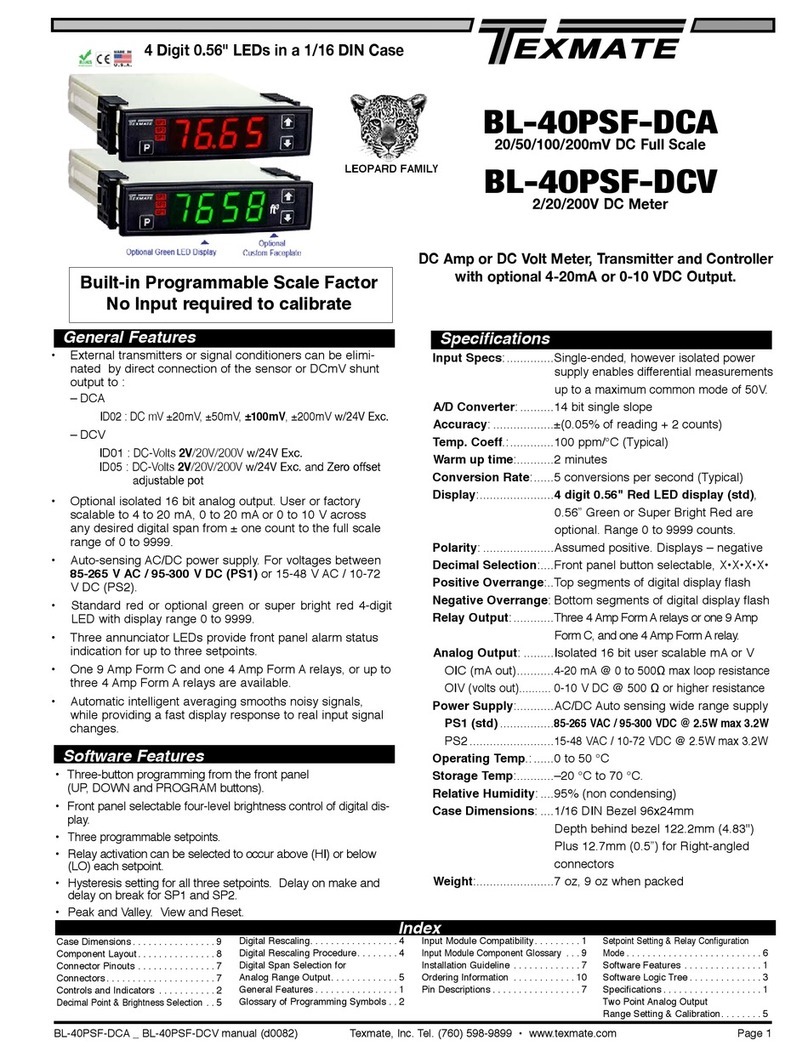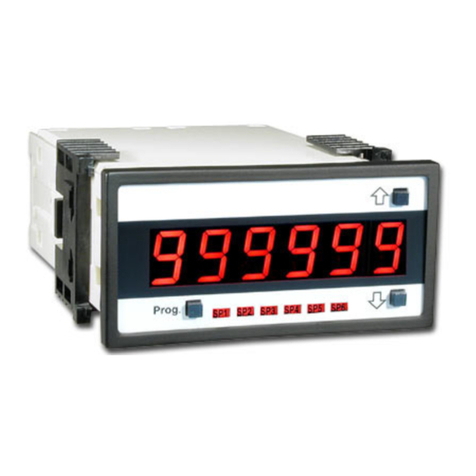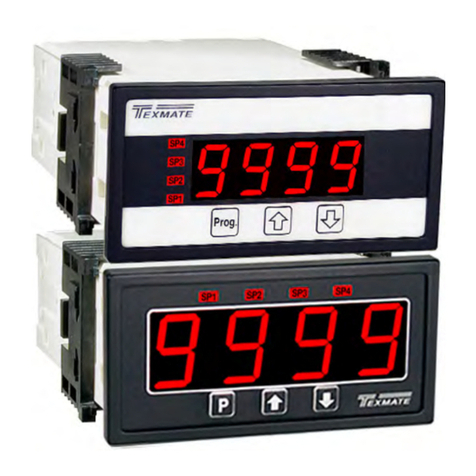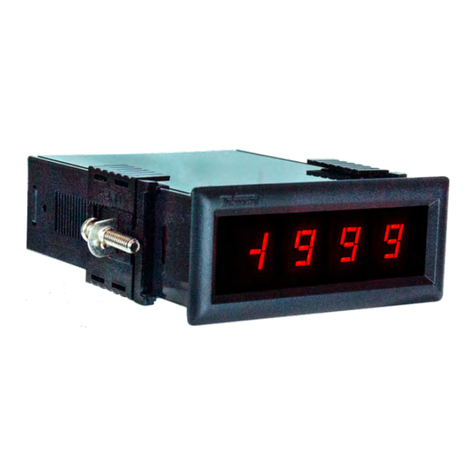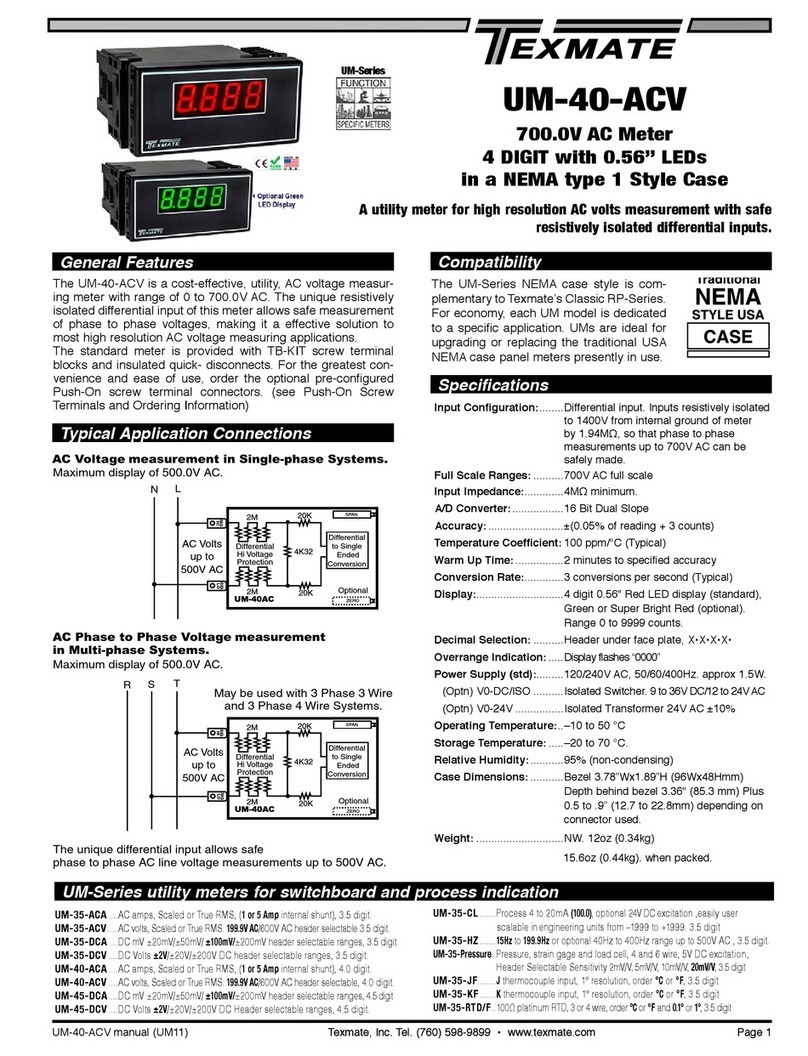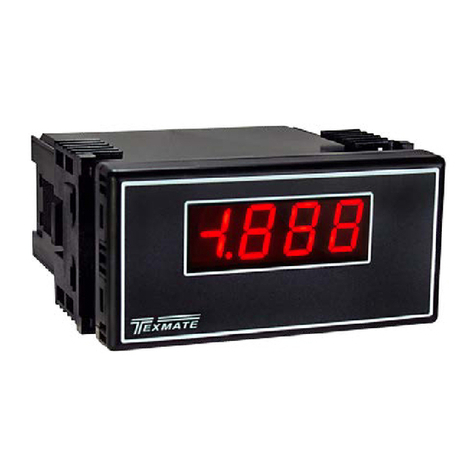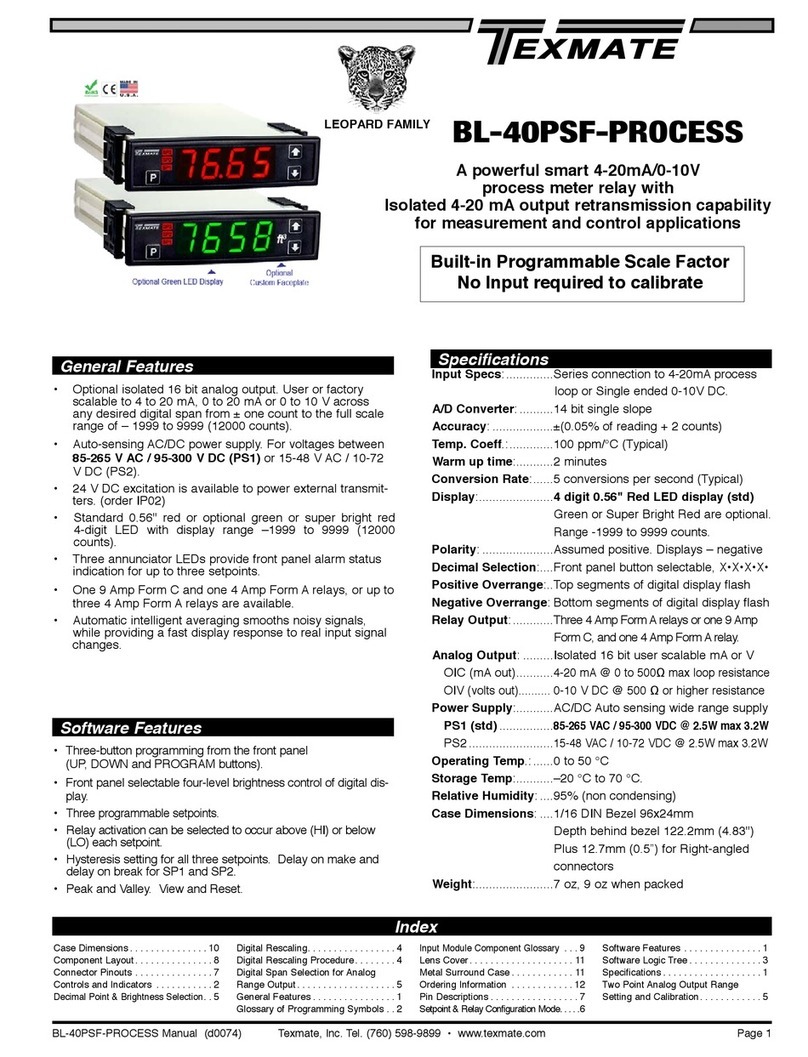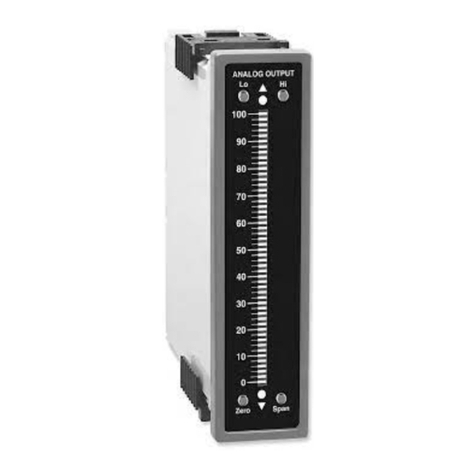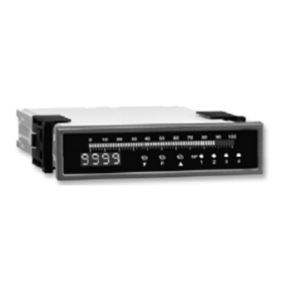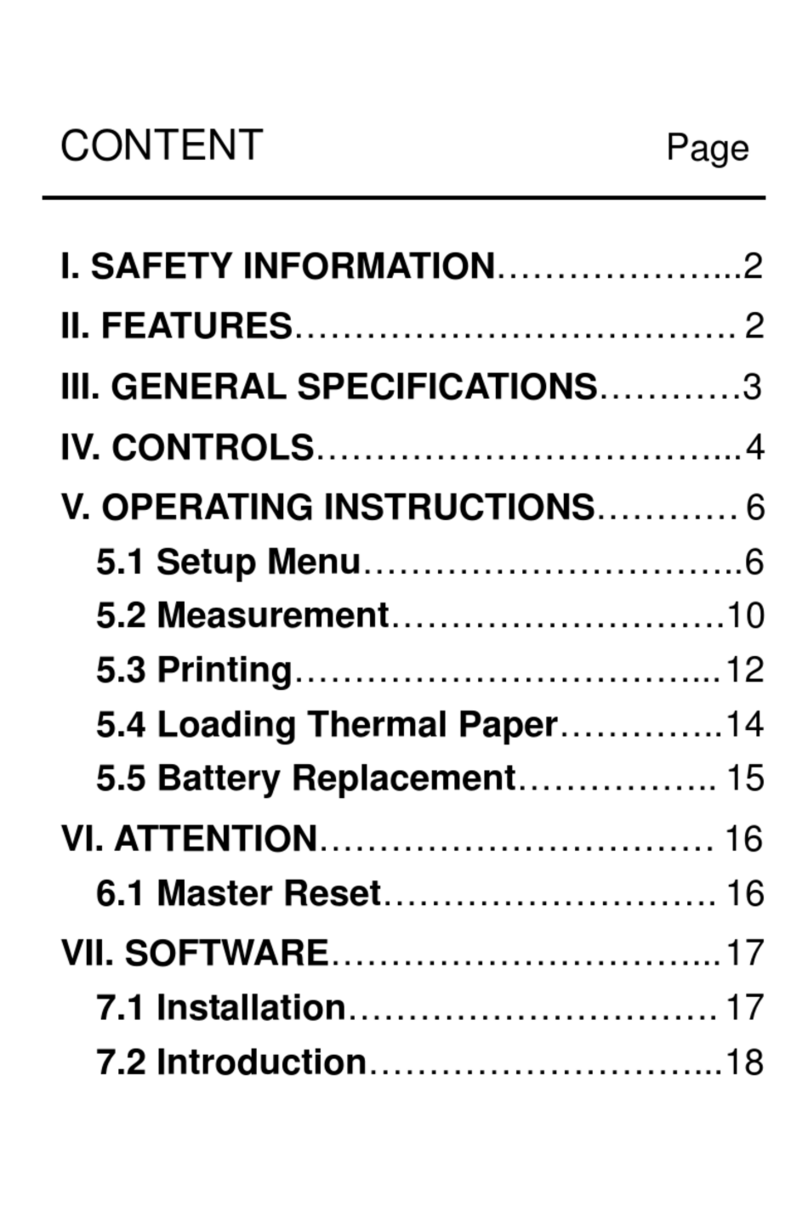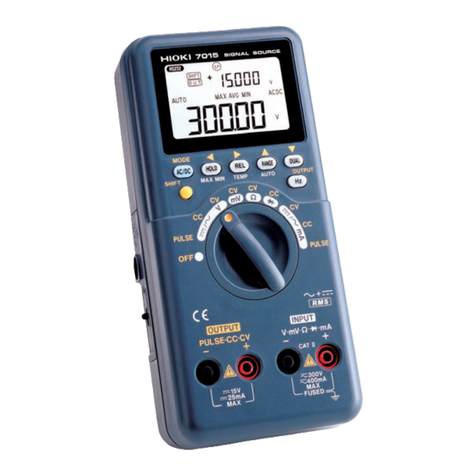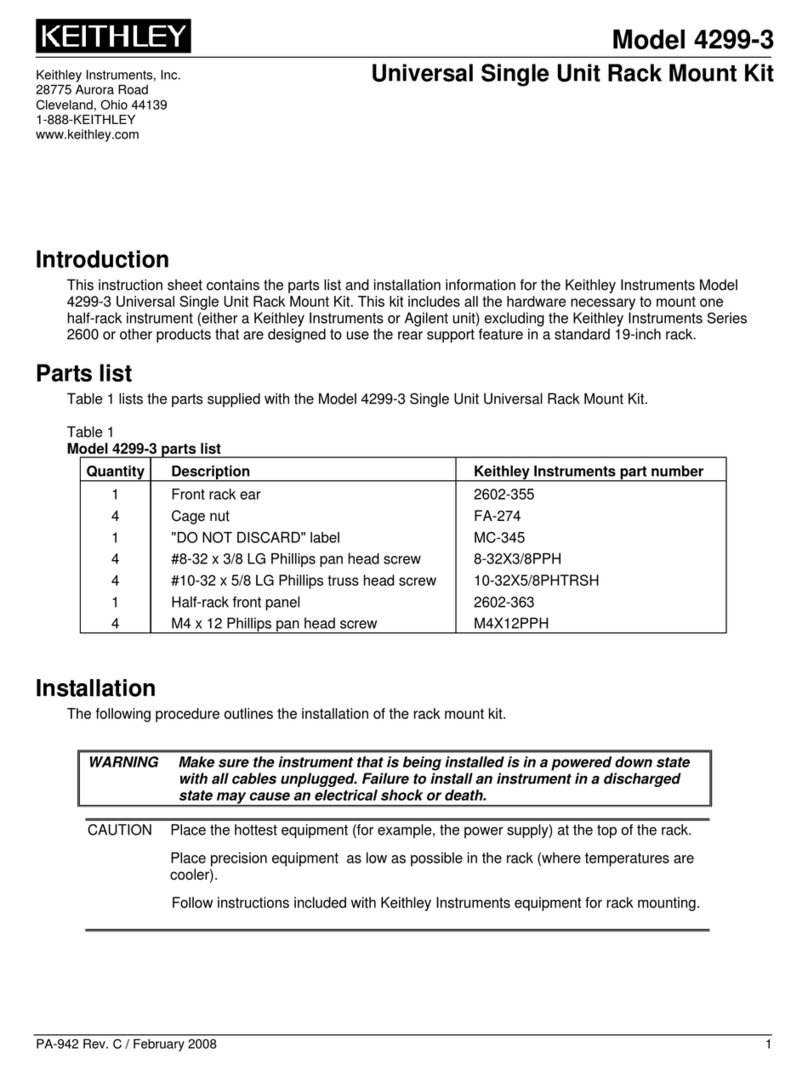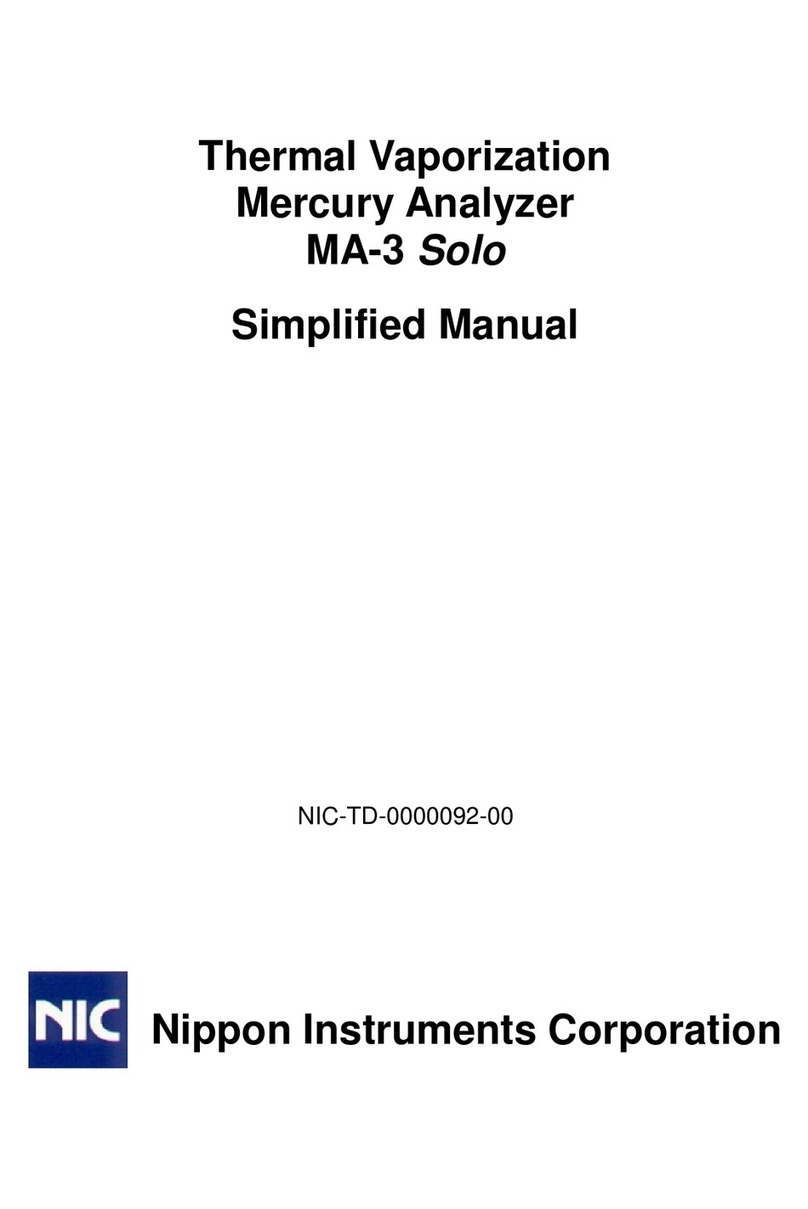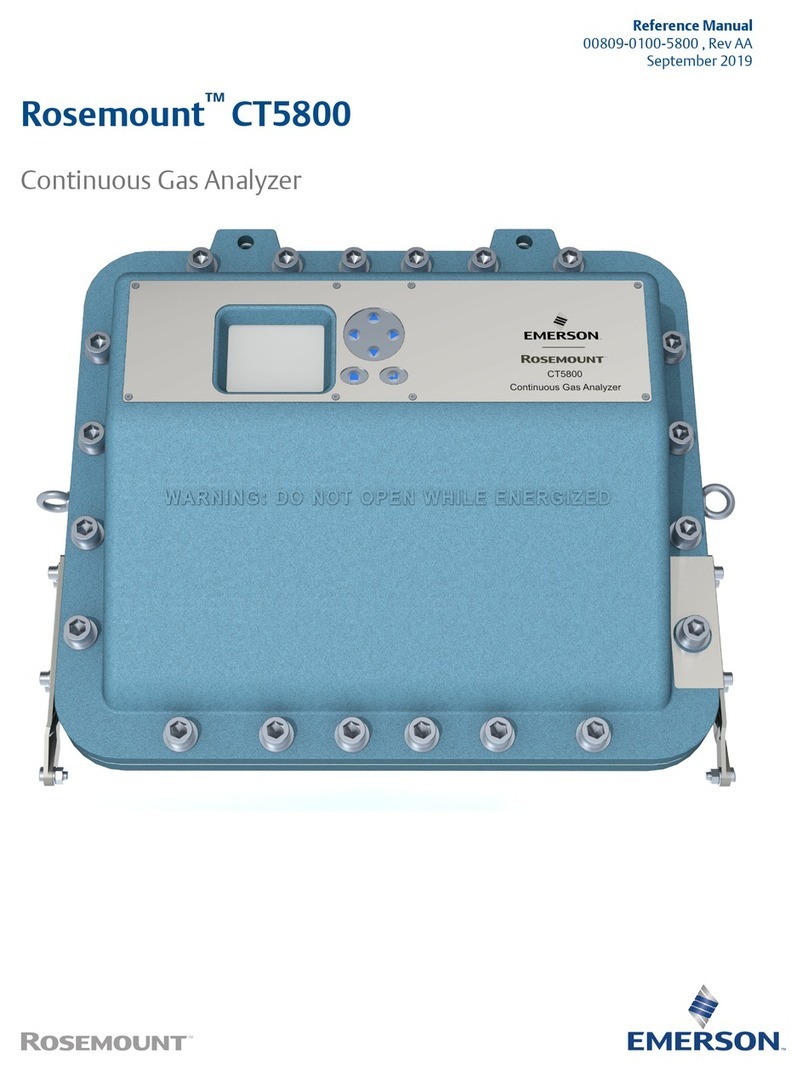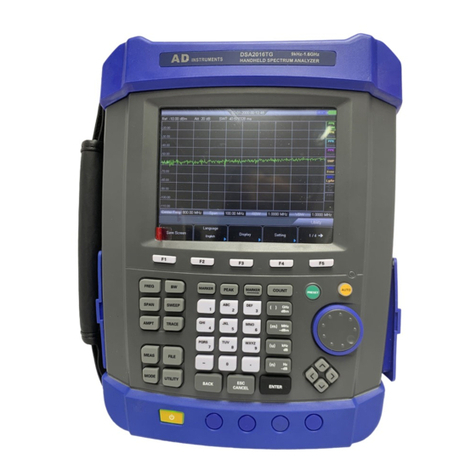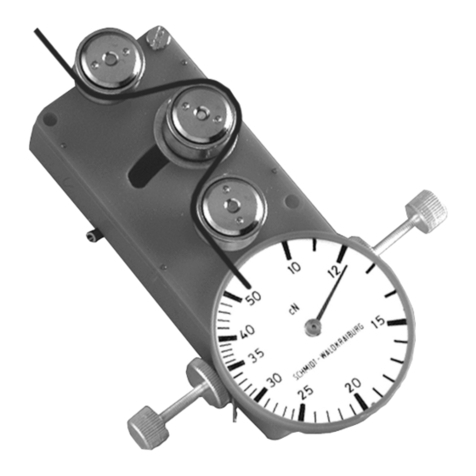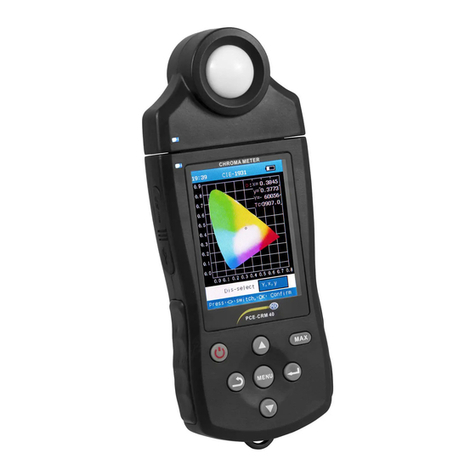
Texmate, Inc. Tel. (760) 598-9899 • www.texmate.comPage 2 PM-35XAC Manual (X3)
Functional Diagram
Connector Pinouts
The Texmate Model PM-35XAC interconnects by means of a
standard PC board edge connector having two rows of 15 pins
each, spaced on 0.1" centers. Connectors are available from
Texmate, or form almost any connector manufacturer.
A
B1 2 345 6 7 8 9 10 11 12 13 14 15
1 2 345 6 7 8 9 10 11 12 13 14 15
CALIBRATION
POTS
Pin A1 - Reference Voltage Output: Internal precision voltage reference.
Standard output is 1.000V, adjustable by ±5% with R10 potentiometer. Usable
voltages from 0.05V to 5.0V for special high impedance scaling can be obtained
by changing the value of internal dividing resistors R8 and R9. It should be noted
that when Pin A1 is referred to System Ground Pin B13 the potential is +1.0V.
However, when Pin A1 is referred to Analog Common Pin B2, the potential is
-5.9V.
Pin A2 - Signal Low Input: Signal low input of A to D converter. Maximum over-
voltage protection is ±500VDC or 350VAC.
Pins A3, A4, A5, A6, A7, A8, A9 and A10 - Descriptors: These are the pins for
the descriptors “m” for mA, K, Ω, A, V, DC, AC, and “m” for mV, respectively. They
may be displayed as required by connecting the appropriate pin(s) to Decimal/
Descriptor Select Common Pin B11; any number of descriptors can be turned on
at the same time. An open circuit will turn off a descriptor; however, static current
pickup and/or PCB leakage of more than 100nA can cause descriptors to turn on
undesirably. Therefore, it is recommended that any unused descriptors be con-
nected to Backplane Output Pin B10 either directly or by a resistor of less than
5MΩ to insure an off condition. CAUTION: Any DC component introduced to the
display drive circuitry can, in time, cause permanent damage.
Pin A11 - “-” Polarity Sign Input: Pin A11 is the negative sign segment of
LCD. For normal operation, Pin A11 is connected to Decimal/Descriptor Select
Common Pin B11. For reversed polarity sign indication, connect Pin A11 to “+”
Polarity Sign Output Pin B12 and connect “+” Polarity Sign Output Pin A12 to
Backplane Output Pin B10. This will cause the minus sign to be displayed when
a positive signal is present. However, in this configuration the plus sign must be
assumed when a negative signal is present.
Pins A12 - “+” Polarity Sign Input: Pin A12 is the positive sign segment
of the LCD. For normal operation, Pin A12 is connected to “+” Polarity Sign
Output Pin B12. SEE DESCRIPTION OF PIN A11 FOR REVERSED POLARITY
OPERATION.
Pins A13, B14, and A15 - No Connection: The PCB pads which would normally
correspond to these pins do not exist on the PCB.
Pin A14 - AC Power Input: Connect one side of the 117V or 230VAC power
input to Pin A14. Model PM-35XAC110 is operated from 110V at 50Hz or 117V
at 60Hz to 400Hz, Model PM-35XAC220 is operated from 220V at 50Hz or 230V
at 60Hz to 400Hz.
Pin B1 - Reference Input: Reference voltage input for A to D converter. Normally
supplied from Pin A1. An external reference source referred to Pin B13 may be
used instead. Pin A1 may be used as an input for ratiometric measurements.
Minimum usable voltage is 0.05VDC, with a maximum voltage of 5.0V. For rati-
ometric operation, displayed reading =1000 X (Signal input Voltage÷ Reference
input Voltage). The maximum signal input voltage is 5V. Higher voltages must
be scaled down through a voltage divider. Reference input voltage must remain
stable during measurement period. NOTE: Consideration should be given to the
common mode voltage of the input signal as the system common mode voltage
range referred to Analog common Pin B2 is -5V to +2V whereas referred to
System Ground Input Pin B13 the common mode voltage range is +2V to +8V.
Pin B2 - Analog Common: Pin B2 is common for the analog section of the meter
which is normally +6.9V above System Ground Input Pin B13. Pin B2 should
not be connected to System Ground Input Pin B13 due to the fact that Analog
Common is regulated to provide the primary precision voltage source for the
Reference Voltage Output Pin A1. This voltage is also the source from which the
offset voltage Output Pin B3 is derived.
Pin B3 - Offset Voltage Output: With the addition of a 3/4" 50KΩ potentiometer
in the R15 position on the PC board, 0 to +6.9V is available from Pin B3 which is
referred to either system Ground Pin B13 or Analog common Pin B2.
Pin B4 - Signal High Input: Pin B4 is the signal high input for all input signals.
When attenuation is not required, the resistor position R1 should be shorted by
a jumper. Dividing resistors may be mounted internally in R1 and R2 positions
to attenuate voltages up to 1200V max. Matched dividing resistors for the 20V
(1/10), 200V (1/100), and 1200V (1/1000) ranges are available from Texmate.
Shunt resistors for current measurements up to 200mA may also be internally
mounted in the R2 position. The current loop is then applied to Pin B4 and
returned thorough Signal Low Input Pin A2.
Pin B5 - +12VDC Power Output: When the meter is operated from an AC
source, Pin B5 provides a +12VDC output, which may be used to power external
circuitry. The maximum auxiliary load is 1mA. When the meter is powered from
a 9 to 15VDC source, Pin B5 becomes the positive terminal of the power input.
NOTE: In some circuit configurations the input signal must be isolated from the
DC power supply.
Pin B6 - Display Test: All display segments will operate when Pin B6 is connect-
ed to 12VDC Power Output Pin B5. The Display Test function is only intended for
momentary operation. Continuous application of Display Test will in time damage
the display.
Pins B7, B8, and B9 - Decimal Select: Decimal points may be displayed as
required by connecting appropriate pin to Decimal/Descriptor Select Common Pin
B11. CAUTION: Decimal display pins have the same operating characteristics as
Descriptor pins and likewise may be damaged from a DC component introduced
by leakage or inadvertent connection to system ground.
Pin B10 - Backplane Output: Liquid crystal displays are operated from an AC
signal. The backplane is the common base of the LCD capacitance structure and
is continuously driven by a square-wave signal at approximately 60Hz. Those
segments that are driven 180˚ out-of-phase with Pin B10 will turn on.
Those segments that are driven in-phase with Pin B10 will turn off.
PIN B11 - Decimal/Descriptor Select Common: Pin B11 is 180° out-of-phase
with Backplane Output Pin B10. Thus, it serves as a common for the descriptors,
decimal select, and the “-” polarity sign. As required, Pin B11 may be connected
to Decimal Select Pins B7, B8, B9 and to Descriptor Pins A3, A4, A5, A6, A7,
A8, A9, A10. The “-” Polarity Sign Input Pin A11 is also connected to Pin B11 for
standard polarity indication.
Pin B12 - “+” Polarity Sign Output: Pin B12 is in-phase with Backplane Output
Pin B10 for negative signal inputs and out-of-phase for positive signal inputs.
Connect Pin B12 to "+" Polarity Sign Input Pin A12 for normal operation. SEE
DESCRIPTION OF PIN A11 FOR REVERSED POLARITY OPERATION.
Pin B13 - System Ground: Pin B13 is the ground return for +12VDC Power
Output, and serves as Power Ground Input (negative side of power supply) when
the meter is powered from 9 to 15VDC source.
Pin B15 - AC Power Input: Connect one side of the 117V or 230VAC power
input to Pin B15.
Component Layout
R15
C7
C5
R7C8U1R16VR1R11R10
R15
R2
R9
R1
R8
R13
C4
R6
R3
R12
Calibration Procedure
After making the appropriate connections as shown in the instructions
apply power to the meter. Then, with a precision DC reference source,
apply +1.900VDC between Signal High Input Pin B4 and Signal low
Input Pin A2. Adjust R10 potentiometer (on left side as viewed form
rear) until the display reads +1.900V. NOTE: This calibration voltage is
for a ±1.999V F.S. meter. For other ranges, the voltage applied should
be similarly proportionate to the selected full scale voltage.
CAUTION: This meter employs high impedance CMOS inputs. Although internal
protection has been provided for several hundred volt overloads, the meter will
be destroyed if subjected to the high kilovolts of static discharge that can be
produced in low humidity environments. Always handle the meter with ground protection.




